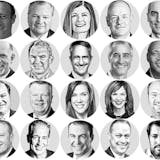The Federal Reserve's latest release of transcripts of its policy-making committee meetings after five years has provided plenty of fodder for the Fed's critics.
Here we were in 2007, at the start of a stomach-churning financial crisis, and hardly a hint in hundreds of pages that anyone in the room saw it coming. They had reams of detailed data on trees and somehow never saw a forest.
Some of that criticism is justified, as forecasts proved so wrong as to be almost absurd. But the record also shows that these Fed officials understood plenty as it was happening. The actions they did take in response set the Fed's course for the kind of stunning intervention that played a key role in later providing stability to an economy then in free fall.
Fed transcripts may sound like grist for monetary policy wonks and academics, but they are a great window into an important role at one of this country's most powerful institutions.
An institution, by the way, not exactly set up for efficiency. The main monetary policy group is called a committee and acts like one. It's made up of seven members of the Federal Reserve Board, the president of the Federal Reserve Bank of New York and four of the remaining 11 bank presidents, although the rest of the bank presidents sit at the table and jump into discussions.
And the critics of the Fed have a point in that meetings in 2007, a dramatic year, seem, well, sleepy. They make announcements about lunch. They settle friendly bets made on the outcome of the NBA finals. They joke about how certain they are to be criticized, no matter what they do.
As a group, they were pretty sunny at the start of the year, more worried about inflation than anything else, as the economy was humming.
The conversations Fed presidents reported to the group from sources in their home districts grew darker as the year progressed. Fed officials openly discussed mortgage default rates, declining credit performance of pools of home mortgages and the near disappearance of any sub-prime mortgage lending.



